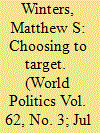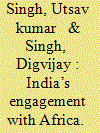| Srl | Item |
| 1 |
ID:
097903


|
|
|
|
|
| Publication |
2010.
|
| Summary/Abstract |
Well-governed countries are more likely to make use of foreign aid for the purposes of economic development and poverty alleviation. Therefore, if aid agencies are providing funds for the sake of development, these countries should receive more aid and categorically different types of aid as compared with poorly governed countries. In poorly governed countries aid should be given in forms that allow for less discretion. Using an original data set of all World Bank projects from 1996 to 2002, the author distinguishes programmatic projects from investment projects and national from subnational investment projects. If the World Bank allows more discretion in well-governed countries, then it will choose to provide programmatic and national aid for these recipients. The author presents evidence that the World Bank provides a larger proportion of national investment lending in better-governed countries. With regard to programmatic lending, he finds find mixed evidence. Among counties eligible for International Development Association (ida) aid, good governance surprisingly is associated with a lower proportion of programmatic aid, whereas for International Bank for Reconstruction and Development (ibrd) borrowers, good governance is associated with a higher proportion. The author subjects these results to a number of robustness checks. Although he confirms the existing result in the literature that the World Bank provides larger overall amounts of aid to better-governed countries, his examination of the disaggregated data leads to questioning whether both lending wings of the World Bank are designing aid programs in the most prodevelopment way possible.
|
|
|
|
|
|
|
|
|
|
|
|
|
|
|
|
| 2 |
ID:
142261


|
|
|
|
|
| Summary/Abstract |
The International Development Association (IDA), the World Bank's facility for low-income countries, has granted India an unprecedented exception to its usual “graduation” policy—extending transitional support to its largest borrower, even though it has crossed the normal eligibility cutoff for IDA’s soft loans (based on per capita income). Before 2012, some Indian officials had called for a “graceful graduation,” believing that India did not need concessionary development assistance any longer. But with IDA graduation imminent in 2013 and facing a limit on borrowing from the Bank’s other window for middle-income countries, the International Bank for Reconstruction and Development, India successfully appealed for continued IDA access. This article draws on official interviews and documents to show how India secured post-graduation transitional support from IDA—suggesting that while India’s leaders seek to present their country as a rising power with influence in multilateral institutions, they can also be pragmatic in their status demands and quietly persuasive in their economic diplomacy.
|
|
|
|
|
|
|
|
|
|
|
|
|
|
|
|
| 3 |
ID:
148115


|
|
|
|
|
| Summary/Abstract |
Indian economy has entered in the 25th year of liberalization in year 2016. “In 1991, India was infamous as the world’s biggest beggar, a bottomless pit for foreign aid. It soaked up 40% of the funds of the International Development Association (IDA), the soft-loan window of the World Bank. Today, India is as much a donor as a recipient. It is still a substantial aid recipient in gross terms. But the inflow is barely half-a-billion dollars net of debt service.
|
|
|
|
|
|
|
|
|
|
|
|
|
|
|
|